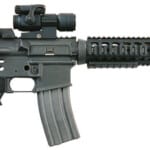
Marlin Firearms: A Legacy of American Craftsmanship and Innovation
Marlin Firearms stands as one of the most respected names in the American firearms industry, known for producing reliable, high-quality rifles for over a century. With a history deeply rooted in innovation and excellence, Marlin has carved out a significant legacy in lever-action rifles, semi-automatic firearms, and bolt-action designs. This article delves into the storied past, technical advancements, and enduring influence of Marlin Firearms, ensuring a comprehensive look at this legendary manufacturer.
Founding and Early History
Marlin Firearms was founded in 1870 by John Mahlon Marlin, a skilled gunsmith based in New Haven, Connecticut. While some sources suggest he may have worked at Colt, there is no concrete evidence supporting this claim. Marlin’s early production focused on single-shot spur-trigger revolvers and derringers, which were widely used for personal protection in the post-Civil War era.
Recognizing the growing demand for high-powered rifles, Marlin expanded into long guns, culminating in the introduction of its first lever-action rifle, the Marlin Model 1881. This rifle was notable for its solid-top receiver and side ejection port, a departure from Winchester’s traditional top-eject designs. The Model 1881 was well received for its ability to handle larger calibers, including the .45-70 Government, a powerful round that became a staple in big-game hunting.
Expansion and Key Innovations
Marlin continued refining its lever-action rifle designs, introducing groundbreaking models that set new standards for accuracy, durability, and reliability.
Marlin Model 1893 – Smokeless Powder Evolution
In 1893, Marlin introduced the Model 1893, which became the first Marlin rifle specifically designed to accommodate smokeless powder cartridges. The rifle was chambered in .30-30 Winchester, a revolutionary cartridge known for its high velocity and improved terminal ballistics. This move positioned Marlin as a major competitor to Winchester’s Model 1894.
Marlin Model 1895 – Big-Game Power
The Marlin Model 1895, introduced in 1895, was designed for high-pressure loads and became a favorite among hunters. Chambered for the .45-70 Government, this rifle provided the stopping power needed for large game such as moose, elk, and even bear. Marlin later introduced variants of this rifle to accommodate modern cartridge advancements while maintaining its rugged dependability.
Marlin Model 1894 – A Versatile Workhorse
The Model 1894 was another major milestone, offering a compact lever-action rifle capable of firing pistol cartridges like the .44-40, .45 Colt, and .44 Magnum. This design was particularly favored among cowboys, law enforcement officers, and sport shooters, and its versatility made it one of Marlin’s most successful rifles.
Micro-Groove Rifling – A Precision Revolution
In 1953, Marlin introduced its groundbreaking Micro-Groove rifling, a system that employed multiple shallow grooves instead of the traditional deep-cut rifling. This technology improved accuracy, barrel longevity, and reduced fouling, particularly in .22 LR rimfire rifles and the .30-30 Model 336.
Marlin Model 60 – The Best-Selling Semi-Automatic .22 Rifle
In 1960, Marlin released the Model 60, a semi-automatic .22 caliber rifle that quickly became one of the best-selling rimfire rifles in history. Its tubular magazine, reliable blowback action, and affordable pricing made it a favorite among recreational shooters, small-game hunters, and youth marksmen. To date, over 11 million Model 60s have been produced.
Marlin Firearms in Military History
Marlin’s impact extended beyond civilian markets and into military production. During World War I, Marlin acquired the manufacturing rights to the Colt Model 1895 machine gun, redesigning it into the Marlin M1917 and M1918. These machine guns were deployed extensively in trench warfare and early military aviation.
During World War II, Marlin played a significant role in producing aircraft-mounted M2 machine guns, submachine guns, and other wartime equipment. The company received the prestigious Army-Navy "E" Award for excellence in wartime production.
Corporate Transitions and Ruger’s Revival of Marlin
After John Marlin’s passing in 1901, the company was acquired by Marlin-Rockwell Corporation, which focused on military production before going bankrupt in 1923. In 1924, Frank Kenna Sr. purchased the assets and revitalized Marlin Firearms, returning the brand to prominence.
Marlin remained a family-run company until 2000, when it was sold to Remington Arms, a subsidiary of Freedom Group. Unfortunately, Remington’s mismanagement led to a decline in quality, particularly in post-2010 Marlin rifles. Following Remington’s bankruptcy in 2020, Ruger & Co. acquired Marlin, investing in advanced CNC machining and quality control improvements.
In 2021, Ruger reintroduced the Marlin 1895 SBL, a lever-action rifle chambered in .45-70 Government, to critical acclaim. The new Marlins feature tight tolerances, improved barrel quality, and enhanced finishes, bringing the brand back to its former glory.
Competition with Winchester and Other Rivals
Throughout its history, Marlin has been a fierce competitor to Winchester Repeating Arms. Winchester’s top-eject lever-action rifles, such as the Model 1873 and Model 1894, were dominant in the Old West, while Marlin’s side-ejecting designs appealed to hunters and modern shooters who wanted to mount scopes more easily.
Other competitors include Henry Repeating Arms, which has gained market share in the lever-action segment, and foreign manufacturers like Browning and Beretta, who produce high-end rifles. Despite this, Marlin’s commitment to durability, reliability, and American craftsmanship ensures its lasting appeal.
The Enduring Legacy of Marlin Firearms
Marlin Firearms remains one of the most revered names in the gun industry, with a reputation built on innovation, reliability, and classic American craftsmanship. Whether in the hands of hunters, collectors, sport shooters, or law enforcement professionals, Marlin rifles have earned their place in history.
With Ruger’s commitment to quality and the reintroduction of classic lever-action models, Marlin is once again poised to dominate the market. As the brand continues to evolve, its tradition of excellence ensures that Marlin Firearms will remain a trusted name in American gun culture for generations to come.
If you want to discuss Marlin Firearms, check out the Marlin Firearms Forum.
Read more about Marlin here:

If you know of any forums or sites that should be referenced on this listing, please let us know here.




